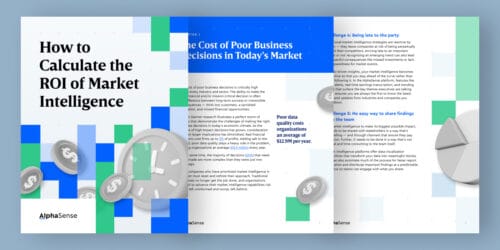- Biden’s Regulation on M&As
- ESG Stances Can Make or Break M&As and IPOs
- How Inflation Affects M&A Deals and IPOs Across Key Industries

How to Calculate the ROI of Market Intelligence
Get the guide
Mergers and acquisitions (M&As) and IPOs flourished in 2021 as dealmaking and investment records that had persisted for years were broken. A total value of deals reaching $2.6 trillion last year – nearly a 30% increase from the previously set record in 2015–led market experts to forecast a similar, financially prosperous activity for 2022. And while Q1 of this fiscal year showed a significant decline in M&A and IPO activity, optimism remained high for a similar outcome.
But as we close on Q4 of 2022, reports show a significant decline in both M&A deals and IPO activity. Regarding the IPO market, activity in the first two months of 2022 paced significantly behind levels witnessed early in 2021–with only 282 global IPOs coming to market, a 43.0% decrease from the same period in 2021. The total amount raised dropped by 66.1% to $128.1 billion, according to S&P Global Market Intelligence data.
M&A demands showed similar behavior, with demand falling by 14% in the three months to the end of September compared to the same period in 2021, according to Thomson Reuters Institute. As of this past February, the total value of announced M&A dropped 25.5% to $517.93 billion from the same period a year earlier, with the number of announcements down by 8.1% to 7,928.
With high hopes crushed for a fiscal year filled with IPO announcements and M&As, many are questioning what went wrong. Market volatility was a top concern for big capital across all industries, obstructing the market landscape 2021 had set for investors, dealmakers and the like. Using the AlphaSense platform, we investigated the obstacles that laid the framework for disappointing QoQs in 2022.
Biden’s Regulation on M&As
In July of 2021, the Biden administration enacted policies that would impact M&A deals in a myriad of economic sectors due to his concern about unchecked dealmaking. In an announcement released by the White House, the President emphasized that a lack of regulation has established monopolies across healthcare, financial services, agriculture and more industries, allowing titans to set high prices for consumers on necessities including prescription drugs, hearing aids, and internet service. To effectively correct this financial burden placed on Americans, dealmaking has been put under a microscope.
But what may be more concerning to dealmakers and C-Suite executives are the intentions Biden has laid out in his announcement. He asked the leading antitrust agencies, the Department of Justice (DOJ) and Federal Trade Commission (FTC), to “enforce the antitrust laws vigorously and recognize that the law allows them to challenge prior bad mergers that past Administrations did not previously challenge.” This call-to-action not only puts some of the top benefiters of M&A last year in hot water but is preventing new, abundant dealmaking activity that ran rampant in 2021.
According to Reuters, among the tactics being deployed by regulators are extensive requests for information and other administrative roadblocks. The Federal Trade Commission stated it was “reapplying the practice of making companies seek the agency’s approval for all deals for the next decade, in exchange for waving through an existing transaction.” However, experts believe private equity firms would likely not face the same scrutiny, effectively allowing them to continue buying out firms and making big acquisitions.
Optimism for Upcoming Fiscal Years
The crackdown on the healthcare, technology and banking sectors outlined in Biden’s statement may have made investors, dealmakers, and the like wary this fiscal year. However, according to a recent survey by Morrison Foerster, 2023 could be a year that sees similar activity to 2021. Whereas dealmakers view 2022 as a year of “reset,” roughly 80% of private equity firms and 71% of corporate firms project to see the number of tech M&A deals increase within the following 12 months.
ESG Stances Can Make or Break M&As and IPOs
Since the concept of ESG first became an investment component that determined company evaluation nearly two decades ago, the implementation of environmental, social, and governance policies throughout industries has dramatically risen.
As consumers are becoming increasingly aware of how manufacturers produce their products and shape their shopping habits to prioritize responsible companies, investors are taking notice. No longer is ESG a token inclusion within the financial reports of major corporations but a factor that can decide the fate of an M&A deal or IPO performance.
Recent news of companies who’ve falsely proclaimed to be ESG-oriented has only fueled focus on corporate authenticity and rising demand for concrete ESG criteria. At the moment, a number of unofficial metrics and organizations specializing in ESG due diligence act as authoritative power in declaring how eco- and socially-conscious a company truly is, some even swaying the evaluations of multi-billion dollar companies with their rankings (i.e. S&P removal of Tesla from its 500 ESG index, and Tesla’s stock dropping by 6%).
Without an unofficial government system or establishment to regulate the promises a company makes, social pressures from investors, consumers and stockholders will continue to drive C-Suite executives to not only adopt but show operational transparency.
The bottom line is that every and any company has an ESG approach that impacts its current and future value.
Perceptions that a strong ESG profile extends only to businesses directly tied to the environment are fading fast, as most analyses that investors conduct today need to be done across asset classes and whether or not an investor is an impact investor or a sustainable investor. It’s a fiduciary responsibility for any advisor to get a full picture of risk-adjusted returns that a company poses. If a company can’t demonstrate a strong understanding of the environment and social issues in which it operates, that’s a major red flag to investors and partners.
How Inflation Affects M&A Deals and IPOs Across Key Industries
The extent to which inflation has damaged the stock market and all affiliated gains is immeasurable. As central banks continue to raise interest rates to combat inflation, M&A faces increasing equity market volatility and rising costs for acquisition financing.
Moreover, every industry has experienced some economic downturn over the past few fiscal years, but some are facing more of the inflation brunt than others.
Technology, Media, and Telecommunications (TMT)
For the TMT sector, a significant drop in deals has headlined sector news, as buyers see the cons of investing outweigh the pros in an unstable market.
“Unsolicited takeovers dominate as public sector discounts make underperforming companies vulnerable to aggressive investors. In the middle and early-stage markets, “soft landings” are peaking as many venture-backed companies find themselves out of other options,” S&P Global states in a report.
IPO activity showed similar results for Q2 of 2022, with only eight US tech IPOs grossing proceeds of $1.2 billion for the quarter–the weakest quarter for the sector in the past four years.
Utilities
Similarly, utility companies are abstaining from engaging in lucrative deals to protect and preserve their balance sheets. Notably, a slew of major companies have conducted internal strategic reviews, divested assets, and sold minority interests in projects to raise cash and facilitate capital reallocation.
Overall, M&A deal value bottomed out to a two-year low point in Q3 2022, dropping 40% compared to Q2 2022 and more than 45% compared to Q3 2021. IPO activity is reportedly slow, with only two major announcements averaging positive returns this fiscal year.
Metals & Mining
Metals & Mining, on the other hand, has seen an increasing amount of M&A activity as companies continue to cash in on high commodity prices. However, inflation and macroeconomic headwinds will inevitably correct prices from their recent highs and are predicted to fall further in 2023. The majority of IPO activity was international for Q3 of 2022–Chinese companies represented 81% of the amount offered.
Financial Institutions
Unlike many other sectors, banks have not seen a decline in their M&A activity as deal opportunities have posed an opportunity to gain scale and cut costs. However, an increasing number of buyers see transactions as less doable due to market volatility. At the end of Q3, this fiscal year raked in $2.7trn worth of M&A deals, down around one-third from 2021 and more companies remaining private on the IPO front.
With the right market intelligence tool, you’ll never have to rely on others’ predictions of how market behavior will unfold, especially when it comes to tracking M&A activity and IPO outlooks. In our white paper, How to Calculate the ROI of Market Intelligence, learn how platforms like AlphaSense can provide you with the information you need to avoid loss and reap gains in turbulent economic times. Start your free trial today.
.png)







